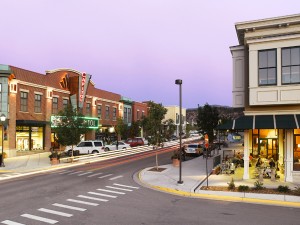Widgetized Section
Go to Admin » Appearance » Widgets » and move Gabfire Widget: Social into that MastheadOverlay zone
Online buying trends are shaping commercial real estate in the Intermountain West
Trends lead developers away from strip malls, toward in-town, walkable development

Eagle, Colorado was one of 32 towns and cities that received special focus as part of the Sonoran Institute’s multi-state review of Commercial Real Estate trends in the Intermountain West.
If the dark, early days of the internet are defined by the weird screeching sound of a dial-up modem, the current internet age can probably be defined by the sound of a cash register pinging up yet another sale.
During the transformation from dial-up to broadband, the online retailer Amazon has become one of the biggest companies in the world, more than two-thirds of internet users in the US say they have made a purchase online, and 68 percent of internet users say that using the internet saves them time.
Get access to the report, a 4-page summary, and other assets by visiting CommunityBuilders.net
This may send a shiver of fear up the spine of our Vail Valley brick-and-mortar shop managers, but rather than going off gently into that good night, retailers are finding that shoppers still love to shop … it’s just that now, rather than an in-and-out purchasing experience, more shoppers in key demographics are seeking a complete shopping experience.
This is where the “quick-and-easy” part of the internet comes in. Today’s shoppers aren’t there to quickly pick something up and hit the road – they’re shopping with family and friends to make a fun day of it. Retailers, in turn, are seeking locations that can offer multiple activities, preferably in an area with a mix of housing, office and retail.
This trend is well established on the national level, but is it happening in places like Eagle County as well?
Trending away from strip malls and toward Main Street
Enter the latest report from CommunityBuilders.net, a project of the Sonoran Institute. Dubbed RESTORE: Commercial and Mixed-use Development Trends in the Rocky Mountain West, the 52-page study (which *phew* comes with a handy 4-page summary and interactive map), examines how online shopping trends have come together with demographic shifts among Generation Y and Baby Boomers, and other changes in the wants and needs of the populace, to create a different trajectory for commercial real estate in the West.
Towns and cities studied in the report:
(Tier A):
Durango, Colo.;
Fort Collins, Colo.;
Grand Junction, Colo.;
Loveland, Colo.;
Parker, Colo.;
Telluride, Colo.;
Boise, Idaho;
Meridan, Idaho;
Billing, Mont.;
Bozeman, Mont.;
Casper, Wyo.;
and Cheyenne, Wyo.;
(Tier B):
Basalt, Colo.;
Carbondale, Colo.;
Eagle, Colo.;
Glenwood Springs, Colo.;
Rifle, Colo.;
Coeur d’Alene, Idaho;
Idaho Falls, Idaho;
Nampa, Idaho;
Helena, Mont.;
Kalispell, Mont.;
Missoula, Mont.;
Jackson, Wyo.;
Laramie, Wyo.;
and Sheridan, Wyo.;
(Tier C):
Buena Vista, Colo.;
McCall, Idaho;
Salmon, Idaho;
Sandpoint, Idaho;
Teton County, Idaho;
and Red Lodge, Mont.
The combination of these forces is pushing commercial real estate trends away from isolated shopping destinations (think malls and strip malls) and toward mixed-use, amenity-driven, pedestrian-friendly developments on Main Street, downtown, or in any kind of thriving town center.
Eagle, Colorado, is one of 32 towns that receives focus in the study.
“When it comes to commercial real estate in the American West today, the hot spot to be is on the corner of downtown Main Street, right in the heart of town, preferably in an area with a mix of housing, office and retail,” said Clark Anderson of Community Builders, which has offices in Glenwood Springs and Bozeman, Montana. “The strip mall isn’t dead, but we’re seeing retailers trying to adapt in an era when e-commerce has taken off and when people do go out to shop, they want a richer experience.”
RESTORE is a sister study to Community Builders’ 2013 study, RESET: Assessing Future Housing Markets in the Rocky Mountain West, which found, among other things, that 90 percent of survey respondents would prefer living within an easy walk to other places in the community.
With RESTORE, Anderson and his team wanted to find out if national trends in commercial real estate are happening in our study region of Idaho, Montana, Wyoming and Colorado. They also wanted to provide analysis and recommendations for realtors, developers, retailers, local government officials, and others in the commercial real estate world could properly deploy to capitalize on these developments.
One size never fits all
Just like elastic-band baseball hats sold in the mall, the one-size-fits-all label is usually sign that someone is stretching the truth.

Hotel McCall in McCall, Idaho, was one of 11 case studies given special focus by our 52-page RESTORE commercial market analysis study. The study also looked at 32 communities throughout Idaho, Montana, Wyoming and Colorado.
And so it is with places like Eagle County where national trends don’t always hold sway, and where the reaction to these trends must be considered in terms of local, on-the-ground realities. All too often, our local leaders are quick to try and jump on a national bandwagon, only to find out the hard way that what works in coastal communities doesn’t always work in the Rockies.
To tackle this problem, RESTORE took stock of 32 towns and small cities throughout the West and classified them into their tiers (A, B, and C). These communities are representative of the Intermountain West as a whole.
Here’s and interactive map of the study region (view the enlarged version here).
Tom Boyd
Latest posts by Tom Boyd (see all)
- GoPro Mountain Games pushed back to August - March 31, 2020
- DockDogs and Rocky Dog trail run create canine character at GoPro Mountain Games - March 7, 2016
- Peace on Earth: read to the end before commenting - January 7, 2015


